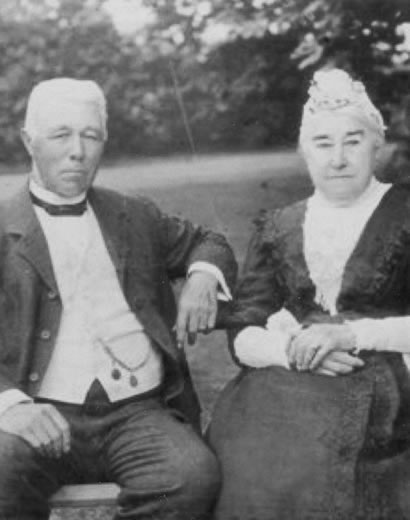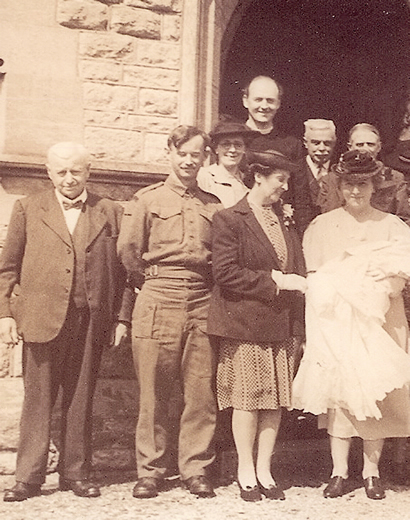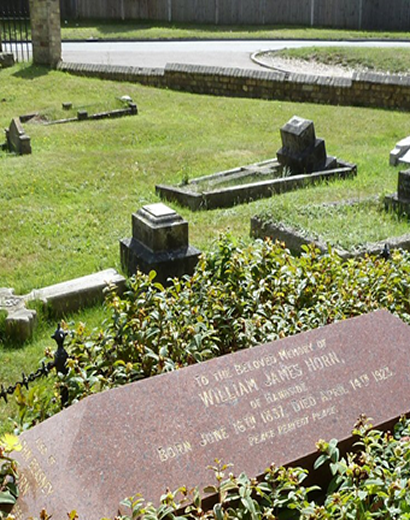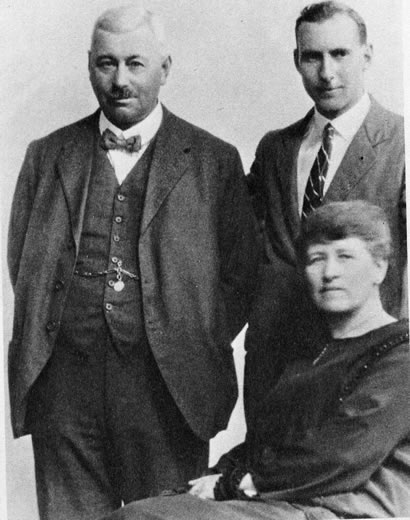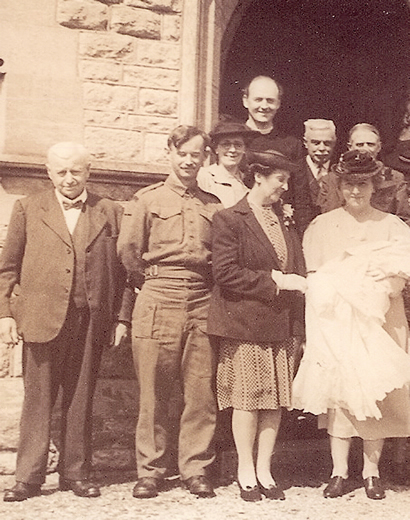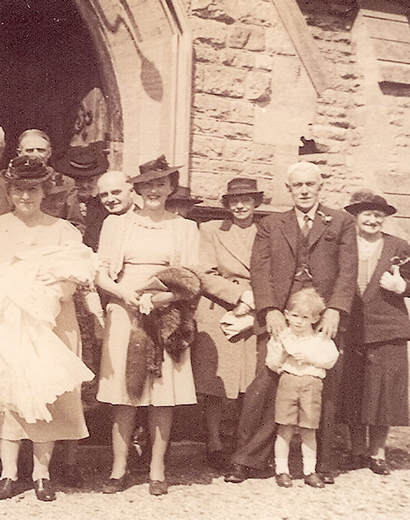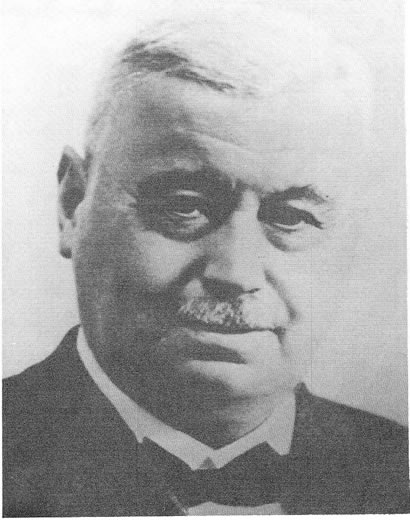William James Horn
Churchwarden of St. John's, Lemsford, for 53 years
William James Horn, the second son of William Cooper Horn and Mary Ann Woodhouse, was born at Lower Handside Farm on the 16th June 1837. Sadly his father died the following year and his older brother, Thomas shortly after. His mother, then only 22, together with her mother, Ann Woodhouse, plus 11 labourers in 1851, ran the 280-acre farm.
She rented more land, so that by the time William married Sarah Cox in 1860, they farmed 130 acres at Upper Handside farm, and she farmed the remaining 280 acres at Lower Handside Farm. Sarah was the daughter of Thomas Cox and Mary Anne Beasney of Hammond's Farm, Sandridge.
William and Sarah had ten children, three of whom died in infancy and are buried, together with their grandmother Ann Woodhouse, in the North churchyard, row 7, plot 9. Three of their sons became farmers and two daughters married farmers, but one son broke the tradition and became a bank manager. Mildred Annie, the youngest daughter, never married.
In February 1897, William Horn purchased the freehold of some cottages he had acquired in Lemsford for £79-2-0 from the Salisbury estate. He later built the redbrick cottages with a distinctive pattern of yellow bricks at the first floor level (Nos 2,4,6,8 10 and 21 & 23 Lemsford Village) for his farm workers. Nos 6, 8 & 10, together with the old Chapel, were demolished in 1964 to make way for the car park for the Long Arm & Short Arm public house.
In 1919, the Panshanger Estate put several farms in mid-Hertfordshire, including the Handside farms, up for sale as they needed money to pay for death duties. The land was bought by Ebenezer Howard and the New Town Trust to build his second Garden City, Letchworth being the first. The Horns were supportive of the idea and were ready to help in the development. It was agreed that they would continue farming whilst the houses and roads were gradually being built around them but they would retire once there was not enough land left to for it to be worth farming.
Apart from being a full time farmer, William James Horn gave his time generously to the community. He was a church warden of St. John's, Lemsford for 53 years, serving from 1868 to 1923 with just a two-year break (1905 and 1907). He was a prominent member, and for many years treasurer, of the Herts Agricultural Society. In 1889 he was elected one of the original aldermen of the newly formed Hertfordshire County Council. He became the first chairman of the Rural District Council and for many years was a Justice of the Peace as well as a member of the Hatfield Board of Guardians. He was a director of the Hatfield Gas Co. for 25 years.
William James Horn died at Handside 14th April 1923, and is buried in the St. John's Lemsford South churchyard, row 2, plot 0 together with his wife Sarah, his sons William Cooper Horn and John Beasney Horn, daughter-in-law May, the wife of William Cooper, and his daughter Mildred Annie.
William James Horn, the second son of William Cooper Horn and Mary Ann Woodhouse, was born at Lower Handside Farm on the 16th June 1837. Sadly his father died the following year and his older brother, Thomas shortly after. His mother, then only 22, together with her mother, Ann Woodhouse, plus 11 labourers in 1851, ran the 280-acre farm.
She rented more land, so that by the time William married Sarah Cox in 1860, they farmed 130 acres at Upper Handside farm, and she farmed the remaining 280 acres at Lower Handside Farm. Sarah was the daughter of Thomas Cox and Mary Anne Beasney of Hammond's Farm, Sandridge.
William and Sarah had ten children, three of whom died in infancy and are buried, together with their grandmother Ann Woodhouse, in the North churchyard, row 7, plot 9. Three of their sons became farmers and two daughters married farmers, but one son broke the tradition and became a bank manager. Mildred Annie, the youngest daughter, never married.
In February 1897, William Horn purchased the freehold of some cottages he had acquired in Lemsford for £79-2-0 from the Salisbury estate. He later built the redbrick cottages with a distinctive pattern of yellow bricks at the first floor level (Nos 2,4,6,8 10 and 21 & 23 Lemsford Village) for his farm workers. Nos 6, 8 & 10, together with the old Chapel, were demolished in 1964 to make way for the car park for the Long Arm & Short Arm public house.
In 1919, the Panshanger Estate put several farms in mid-Hertfordshire, including the Handside farms, up for sale as they needed money to pay for death duties. The land was bought by Ebenezer Howard and the New Town Trust to build his second Garden City, Letchworth being the first. The Horns were supportive of the idea and were ready to help in the development. It was agreed that they would continue farming whilst the houses and roads were gradually being built around them but they would retire once there was not enough land left to for it to be worth farming.
Apart from being a full time farmer, William James Horn gave his time generously to the community. He was a church warden of St. John's, Lemsford for 53 years, serving from 1868 to 1923 with just a two-year break (1905 and 1907). He was a prominent member, and for many years treasurer, of the Herts Agricultural Society. In 1889 he was elected one of the original aldermen of the newly formed Hertfordshire County Council. He became the first chairman of the Rural District Council and for many years was a Justice of the Peace as well as a member of the Hatfield Board of Guardians. He was a director of the Hatfield Gas Co. for 25 years.
William James Horn died at Handside 14th April 1923, and is buried in the St. John's Lemsford South churchyard, row 2, plot 0 together with his wife Sarah, his sons William Cooper Horn and John Beasney Horn, daughter-in-law May, the wife of William Cooper, and his daughter Mildred Annie.


